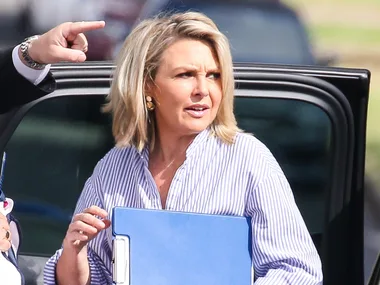He’s the modern day Dalai Lama, inspiring his 11.2 million Twitter followers with daily positive messages. But now he’s also inspiring the women’s movement as he reveals that it would be better if the next Dalai Lama was a female.
Even his friends and fellow Nobel Laureates refer to him as the Feminist Dalai Lama.
Turning 80 on July 6, His Holiness was welcomed to Australia on his recent tour like a rock star. Hundreds of followers were desperate to get a glimpse, a touch, any sort of attention from him, while Hollywood heart throb Richard Gere – who travelled with him – was left in the back ground.
This obsessive attention is something the 79-year-old is used to as he was officially recognised as the 14th Dalai Lama near the town of Bumchen, in 1939 at the age of four.
In 1950, at just 15, he assumed full temporal (political) power after China’s invasion of Tibet in 1949. He was forced to flee his homeland in 1959 after a failed uprising against Chinese rule. Since then he’s never been able to return, residing in the Indian town of Dharamshala, where the Tibetan government in exile is based.
It’s my third meeting in ten years with the spiritual leader of Tibet, and each time I can’t help but be humbled by his presence.
I’m nervous and excited at the same time as he gently steps towards me, loosely draped in his orange robes. I’m warmly greeted with his kind face and we exchange pleasantries.
Tashi Delek (hello in Tibetan) is all I manage to expel as I try and compose myself.
We are in Yulara, the village for residents and tourists visiting Uluru-Kata Tjuta National Park, seated opposite each other in a room where close to 20 of his entourage, including security guards watch our every move.
I’m briefly told by one of his minders that talk of any possibility the Dalai Lama’s reincarnation could be female is just sensationalism and he’d rather I didn’t pursue that line of questioning.
I persisted and His Holiness was more than happy to discuss his genuine support for a female Dalai Lama.
“A female Dalai Lama could be more useful in order to serve Buddha Dalai Lama. I think even according to scientific research, females have more sensitivity and concern about others,” he says.

Liz Deep-Jones interviewing the Dalai Lama.
The Dalai Lama’s institution started in the fifteenth century but a female Dalai Lama would break the age old tradition.
The idea of a female becoming the next Dalai Lama came during an interview in Paris.
“Twenty or thirty years ago, a journalist from a French women’s magazine asked me this question for the first time. Can the Dalai Lama’s incarnation be female? I immediately say, why not because firstly, there are already high female reincarnations among Tibetan lamas,” he says.
“Yes, we accept female gurus, female teachers. The purpose of a reincarnation lineage is to serve people through the Dharma, and if the circumstances are such that a female form is more useful, then why not?”
The 14th Dalai Lama has also previously remarked in a joking manner.
“If the Dalai Lama’s reincarnation is female, she must be very attractive.”
His infectious chuckle brings a smile to all around him. His sense of humour is refreshingly childlike which doesn’t match his body which is gracefully ageing.
His movement slow and measured over the many years he has travelled the earth, sprouting a Middle-Way approach for his homeland.
He hopes to one day achieve a genuine autonomy for all Tibetans living in the three traditional provinces within the framework of the People’s Republic of China.
While the Chinese government stalled talks about the plight of Tibet since 2010, the Dalai Lama continues to modernise his role and efforts for a Free Tibet.
In 2011 he broke a 400 year tradition where the Dalai Lamas had functioned as both political and spiritual leaders of Tibet. He stepped down from the political role after the democratically elected former Harvard law Professor, Dr. Lobsang Sangay, known as Sikyong (Prime Minister) won office to lead the Tibetan government in exile.
Some reports suggest Dr.Sangay is concerned about the Chinese government’s claim to sole authority over the choice and location of the next Dalai Lama. The head of the ethnic and religious affairs committee of the Chinese People’s Political Consultative Conference, Zhu Weiquin, asserted that the “decision-making power over the reincarnation of the Dalai Lama, and over the end or survival of this lineage, resides in the central government of China.”
But as far back as 1969, His Holiness has made it clear that the concerned people of Tibet should decide whether the Dalai Lama’s reincarnations should continue in the future.
“When I am about ninety I will consult with the high Lamas of the Tibetan Buddhist traditions, the Tibetan public and other concerned people who follow Tibetan Buddhism and re-evaluate whether the institution of the Dalai Lama will continue. If so, the next Dalai Lama could be reincarnated outside of Tibet and China.”

Liz Deep-Jones and the Dalai Lama with his gift.
The Dalai Lama’s main concern isn’t whether the next Dalai Lama is male or female. It’s about the institution falling into the wrong hands.
“If it’s decided that the reincarnation of the Dalai Lama should continue and there’s a need for the fifteenth Dalai Lama to be recognised, responsibility for doing so will primarily rest on the concerned officers of the Dalai Lama’s Gaden Phodrang Trust. I shall leave clear instructions about this,” he says.
“Bear in mind that, apart from the reincarnation recognized through such legitimate methods, no recognition or acceptance should be given to a candidate chosen for political ends by anyone, including those in the People’s Republic of China.”
While the 14th Dalai Lama is supposed to be semi-retired, his gruelling schedule doesn’t seem to have affected his current good health. He continues to travel the world spreading his teachings of acceptance and compassion. He also remains optimistic that he’ll one day return to his homeland.
“Yes, I’m certainly expecting to return to Tibet.”
You have to admire his positivity at a time when the Chinese government refer to him as “a devil with horns” and have halted discussions with Tibetan officials since 2010.
In the heart of Australia you can’t help but be swept up by his sense of hope and presence of enlightenment. Our time together unfortunately comes to an end.
I present the global face of the Tibetan struggle a parting birthday gift – a hat from my son Dylan’s local football team, Dunbar Rovers FC.
The Dalai Lama threw in his infectious laugh, as I handed it to him.
After close inspection he indicates he’s delighted by the football clubs symbol of a pink lion. Maybe he can relate to this as in Buddhism, lions are symbolic of the bodhisattvas (beings who have attained a high level of spiritual development) – the “sons of the Buddha” or “Buddha’s lions”.
He proudly placed the cap on his head as I thanked him for his time.
This modern day Dalai Lama isn’t feigned by intimate moments. He’s changing the role and breaking new ground during his tenure.
I then wonder if a female Dalai Lama would also enjoy the same control and reverence the 14th Dalai Lama has been blessed with for most of his life.











